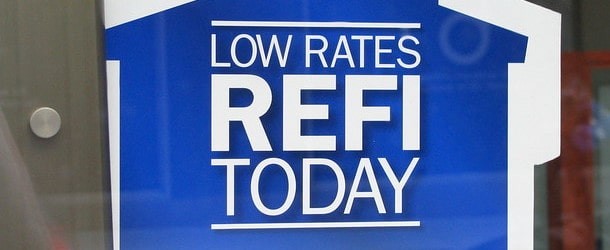
With mortgage rates at or near all-time record lows, you’ve likely pondered a refinance if you’re an existing homeowner.
But you probably also have a lot of questions too, especially if it’s your first time refinancing a home loan.
Let’s clear up some of the confusion by tackling some of the most common refinance questions out there.
1. When is a good time to refinance?
As noted, long-term fixed-rate mortgage rates are near their lowest point in history. This make refinancing super attractive right now for anyone that has a stale interest rate.
But there are other reasons to refinance too, such as to tap home equity to furnish improvements or to pay down other debt or other expenses.
While there are some refinance rules of thumb out there, a one-size-fits-all solution doesn’t exist.
However, it’s pretty easy to know when to refinance if your current mortgage rate is significantly higher than today’s market rates.
For example, if interest rates are 1% lower, or even .50%, it’s typically a no-brainer.
Just take the time to do the math first, and to think through how long you plan to keep the property/new loan, and what your loan payoff goals are.
2. Do I have to wait to refinance?
Another common refinance question pertains to waiting periods and refinance frequency. That is, how long until you can refinance, and how many times can you do one?
While there are certain waiting periods depending on the type of home loan in question, you can generally refinance right away and as many times as you like, within reason.
However, a lender may lose their commission if you refinance too quickly, generally if less than six months have passed since you closed your previous loan.
If there is a certain waiting period, you might be able to refinance into a different loan type, such as from a FHA loan to a conventional loan to forgo the requirement.
This way you won’t miss out if you feel mortgage rates are going to rise in the short-term.
Just be careful not to become a serial refinancer, as it can cost money to refinance your mortgage each time, and potentially set you back from paying the thing off.
3. Are refinance rates more expensive?
Generally, refinance rates are higher than home purchase loan rates, though typically only marginally, and sometimes not at all.
Plus, you might find that when refinancing, the new bank or lender you use turns out to be cheaper than the one you used to finance your home in the first place.
While interest rates can be exactly the same for a rate and term refinance and a home purchase, be sure to pay attention to any points and/or closing costs.
And note that cash out refinances will often be more expensive, possibly .25% to .375% higher depending on all the loan attributes. This is because a larger loan amount is inherently riskier.
4. Should I take cash out of my home?
When refinancing, you’ll be given the option to take cash out of your home, assuming you’ve got sufficient equity to do so.
Often, this is a question you’ll be asked when completing a preliminary lead form. It’s entirely optional and really driven by need.
Do you need cash? Do you have other expenses or high-interest rate debt that could be paid off via a cheaper mortgage?
Take the time to determine if a cash out refinance makes sense versus simply obtaining a new rate and term.
Remember, the interest rate will likely be higher if you opt for cash out, so reserve it for a specific need.
And note that it’ll slow down any payoff goal you’ve got as you’ll wind up with a larger loan amount.
5. Should I go no-cost or pay fees?
Another decision you’ll need to make when refinancing is whether to pay closing costs out-of-pocket or to opt for a lender credit.
Most lenders will offer a no cost refinance option to make it look more appealing – who doesn’t like a lower rate they don’t have to pay for?
Ultimately, you do still pay for it, via a slightly higher interest rate. Of course, it can be worth it not to pay points or fees in exchange for a marginally higher monthly payment.
After all, it’ll still be cheaper than your old mortgage payment, and you may not want to put any more money into your house, especially if you move or refinance again in the near future.
As always, do the math to determine which approach makes more sense based on your wants/needs. Certainly put in the time to do a side-by-side analysis.
6. What loan term should I get?
If you have a 30-year fixed mortgage right now, you’ll probably just get another 30-year fixed. It’s the most common and popular loan program out there.
But the 15-year fixed is the second most popular loan program out there, and an even more common choice for existing homeowners who refinance.
Why? Because it means you don’t reset the clock when refinancing, that is, extend the loan term beyond its original duration.
Assuming you actually want to pay off your loan sometime this century, it can make sense to refinance into a shorter-term loan.
Aside from staying on track to pay off your loan, 15-year fixed mortgage rates are cheaper than their 30-year fixed counterparts.
7. Can I really skip a payment?
A common pitch used by loan officers, mortgage brokers and lenders is that you can skip a mortgage payment when refinancing.
Obviously, the thought of not having to make a monthly payment, especially on a large home loan, is enticing.
So is it true? And if so, how does it work? It is indeed true, and it works by closing your loan at a certain time of the month.
This way you don’t need to pay your old lender, and your new loan’s first payment won’t be due for a month or longer.
This can provide you with some mortgage payment relief, but it’s not really skipped – it’s simply delayed. Still, this can be beneficial from a short-term cash flow perspective.
Just note that the downside is you’re slowing down your loan payoff slightly by delaying mortgage payments.
8. Does my refinance require another appraisal?
I recently talked about how refinances don’t always require an appraisal. And this is becoming more and more common as technology improves.
Simply put, companies like Fannie Mae and Freddie Mac are leveraging data to determine if and when an appraisal is actually necessary.
If their automated underwriting system determines that a manual appraisal isn’t necessary, they may issue an appraisal waiver.
This can save you money (hundreds of dollars) and shorten the time it takes to get a mortgage.
But it only works on certain types of refinances, namely rate and term refis.
The thinking is a borrower obtaining a lower rate and corresponding monthly payment is less risky, especially if they have property value data in their database that says the value inputted is on point.
9. Can I refinance with poor credit?
Yes, you probably can, depending on your definition of poor. Is it advisable? That’s another question.
Ultimately, you’re going to want a credit score of at least 620 in most cases to entertain a mortgage refinance, though scores can be lower for FHA loans and VA loans depending on the lender.
However, a poor credit score can increase your mortgage rate, making the refinance less worthwhile (you’re doing it to save money remember!).
So your goal should be to improve your credit scores before applying for a refinance. Sure, you can look into if you’ve got a bad or marginal score, but you may find that the interest rate offered isn’t too hot.
A better plan is to boost your scores, then shop for that refinance, which should result in much bigger savings.
10. Can a refinance damage your credit?
Now let’s look at the other side of coin – the idea that a refinance can hurt your credit score.
While any request for new credit (a refinance is a new credit line) can push your scores lower, it typically won’t do much damage.
Sure, there are the mortgage inquiries and the existence of a new credit account on your credit report, but often you won’t see your scores fall more than a handful of points.
And even then, if you got your refinance done, who cares if your scores are depressed by five points or so for a month or two?
The takeaway is the savings from the refinance should easily eclipse any temporary credit score ding, which may or may not even take place.
11. Can I refinance without equity?
Yes. There are streamline refinance programs available for all the major loan types that allow you to complete a rate and term refinance, even if you have zero equity in your home.
This includes FHA loans, VA loans, USDA loans, and conventional loans backed by Fannie Mae and Freddie Mac.
For conforming loans backed by Fannie/Freddie, it used to be known as the Home Affordable Refinance Program (HARP). Today it’s called a HIRO refinance, which is short for high-LTV refinance option.
There are rules that apply, such as clean mortgage payment history, loan seasoning, and minimum LTVs, but it should be easier than a traditional refinance and provide payment relief.
And most banks, brokers, and lenders out there offer these programs.
12. Why do I need to pay for title insurance again?
There are two types of title insurance, one for the lender and one for the borrower. When you refinance your home loan, it’s obligatory to purchase a new lender’s title insurance policy.
This protects the lender, even if you use the same exact lender again, from title defects and issues related to chain of title (lawsuits, claims, etc.).
The good news is you should be able to get your hands on the “reissue rate,” which is supposed to be cheaper than a brand-new policy.
The bad news is this is one of the many unavoidable costs associated with a refinance, though as noted earlier, it can be absorbed via a lender credit.
13. Should I lock or float?
This is the million-dollar question all borrowers will ask themselves, and perhaps their broker or loan officer.
Ultimately, no one has a crystal ball, nor can they predict the future. Like most things financial, mortgage interest rates can change daily, and even throughout the day.
They can go up, down, or simply remain unchanged. During volatile times, rates can swing wildly in either direction, resulting in a material change to your mortgage payment.
The takeaway is to lock your rate when you’re happy, and to float it if you believe you can do better, but can live with rates moving higher.
Those with a longer timeline until closing have a greater chance of securing a lower rate via floating, just based on the sheer amount of time for rates to drift lower.
Conversely, if closing soon you won’t have as many opportunities to see an interest rate improvement, and might as well lock.
14. What’s in it for the lender?
Sometimes homeowners are confused as to how the mortgage broker or lender that closed their loan in the past would benefit by offering them a lower interest rate.
For example, if your home purchase loan was set at 4% with Bank A, then they contacted you with an offer of an even better 3% mortgage rate, you might be left scratching your head.
The answer is that your loan was likely sold off shortly after it funded, and they made their profit when it did.
Now they can offer you a subsequent refinance and make a commission again, with the investor of the loan the one perhaps losing out.
It’s also pretty common to refinance with a different bank or lender the second time around, so even if the loan was held in portfolio as opposed to sold, the new lender could profit from the refinance.
At the end of the day, it shouldn’t really matter what they’re making on your loan as long as you’re saving money, and you’ve taken the time to shop around for the best rate and closing costs.
So that’s that – hopefully a mortgage refinance doesn’t feel as daunting anymore. Sure, they can be stressful and time consuming, but the potential return on investment is typically unmatched.



